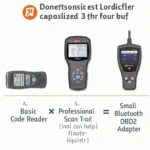The OBD2 DLC data link, or OBD-II Data Link Connector, is the gateway to your car’s internal systems. It’s a standardized 16-pin connector that allows diagnostic tools, like OBD2 scanners, to communicate with a vehicle’s electronic control units (ECUs). Understanding this vital link is key to unlocking a wealth of information about your car’s performance, emissions, and overall health.
Accessing the OBD2 DLC data link allows you to retrieve Diagnostic Trouble Codes (DTCs), monitor real-time sensor data, and even perform certain maintenance functions. From identifying a faulty oxygen sensor to understanding why your check engine light is on, the OBD2 data link connector provides crucial insights into your vehicle’s operation. This article dives deep into the OBD2 DLC, exploring its functionalities, pinouts, and significance in modern vehicle diagnostics.
Decoding the OBD2 DLC Data Link Connector
The OBD2 DLC’s standardized design ensures compatibility across various vehicle makes and models. This uniformity simplifies the diagnostic process for mechanics and car owners alike. Each of the 16 pins in the OBD2 data link connector has a specific function, ranging from power supply to communication lines. Some pins are manufacturer-specific, allowing for enhanced diagnostics within certain car brands.
You might be interested in the pinout for specific car models, such as the 2005 Mazda Tribute OBD2 pinout. Understanding the assigned function of each pin is crucial for interpreting the data retrieved through an OBD2 scanner.
Why is the OBD2 DLC Data Link Important?
The OBD2 data link connector has revolutionized vehicle diagnostics and repair. Before its standardization, diagnosing car problems often involved lengthy and complex procedures. The OBD2 DLC simplifies this process, providing a quick and efficient way to access crucial vehicle data.
Benefits of Using the OBD2 DLC Data Link
- Quick Diagnosis: The OBD2 port offers a rapid method to pinpoint the root cause of vehicle issues.
- Reduced Repair Costs: By accurately identifying the problem, the OBD2 data link helps avoid unnecessary repairs.
- Improved Vehicle Performance: Monitoring sensor data through the OBD2 port enables adjustments for optimal performance.
- Emission Monitoring: The OBD2 DLC plays a crucial role in monitoring vehicle emissions and ensuring compliance with environmental regulations.
For example, if you’re curious about the OBD2 port on a 98 E250, the OBD2 DLC provides a standardized access point for diagnostics.
Where Can I Find My OBD2 DLC Data Link?
The OBD2 DLC location is typically within easy reach of the driver. Common locations include under the dashboard, near the steering column, or in the center console. The location can vary slightly depending on the vehicle’s make and model. You can find information on specific models, such as the Toyota Camry 2009 OBD2 location.
Locating the OBD2 DLC in Your Vehicle
- Check Your Owner’s Manual: The owner’s manual often provides precise information on the OBD2 DLC location.
- Look Under the Dashboard: The most common location is beneath the dashboard on the driver’s side.
- Inspect the Center Console: Some vehicles have the OBD2 port located inside the center console.
“The OBD2 DLC has become an indispensable tool for anyone working with vehicles,” says automotive expert, John Miller, ASE Certified Master Technician. “Its standardized design and accessibility have simplified diagnostics, saving both time and money.”
Understanding OBD2 DLC Data Link Protocols
The OBD2 DLC uses several communication protocols to transmit data between the vehicle’s ECUs and the diagnostic tool. These protocols define how the information is formatted and exchanged. The most common protocols include CAN, J1850, ISO 9141-2, and KWP2000.
Knowing the correct protocol for your vehicle is essential for choosing a compatible OBD2 scanner. The Ford Focus OBD2 slots demonstrates the standardized 16-pin configuration that facilitates these communication protocols.
“Understanding the different OBD2 protocols can seem daunting at first,” adds Sarah Chen, Lead Automotive Engineer. “However, most modern OBD2 scanners automatically detect the correct protocol, making the diagnostic process seamless.”
In conclusion, the OBD2 DLC data link is an essential component of modern vehicle diagnostics. Its standardized design, accessibility, and ability to provide a wealth of information make it an invaluable tool for both professionals and car owners. Understanding the OBD2 DLC empowers you to take control of your vehicle’s maintenance and ensure its optimal performance.
FAQ
- What does OBD2 DLC stand for? OBD2 DLC stands for On-Board Diagnostics, Second Generation, Data Link Connector.
- Where is the OBD2 port located? The OBD2 port is typically located under the dashboard, near the steering column, or in the center console.
- What can I do with an OBD2 scanner? You can retrieve diagnostic trouble codes, monitor real-time sensor data, and perform certain maintenance functions.
- Are all OBD2 scanners the same? No, OBD2 scanners vary in features and capabilities.
- Do I need a professional to use an OBD2 scanner? No, many OBD2 scanners are user-friendly and designed for DIY use.
- What are OBD2 protocols? OBD2 protocols are standardized communication methods used by the OBD2 system.
- How do I find the correct OBD2 protocol for my car? Most modern scanners auto-detect the protocol, or you can check your owner’s manual.
For further information on OBD2 DLC connector pinouts, you can refer to our detailed guide: OBD2 DLC Connector Pinout.
For any support, please contact us via WhatsApp: +1(641)206-8880, Email: [email protected] or visit our office at 789 Elm Street, San Francisco, CA 94102, USA. Our customer service team is available 24/7.


